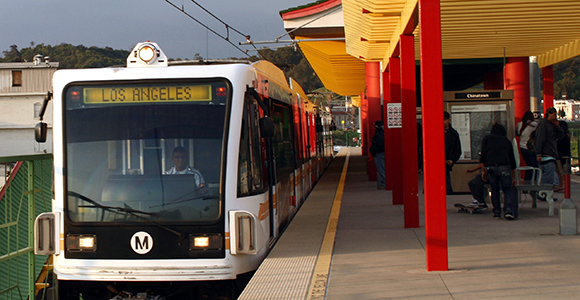
Gold Line station in the Chinatown neighborhood of Los Angeles. (Photo Credit: Prayitno/Flickr)
California's neglect of its infrastructure funding must be turned around. People who are paying attention to this issue say it's time for California to face its inadequate and deteriorating infrastructure.
It has been a principal priority for the California Economic Summit since it was conceived in 2012. Business and civic leaders in every region of the state have highlighted stronger infrastructure financing as a top priority for the state's economy.
It's not surprising that dozens of local leaders showed up to a meeting last week in Los Angeles where a new governance and finance model for local and regional infrastructure was the main topic.
They were there to learn more about Enhanced Infrastructure Financing Districts–also known as “EIFDs”–at the gathering presented by Southwest Megaregion Alliance (SWMA), in partnership with the Southern California Association of Governments (SCAG) and California Forward.
“It is a desperately needed tool,” said Mark Pisano, president of the SWMA and former long-time executive director of SCAG. Pisano and California Forward's Fred Silva were given praise as architects of the idea that helps governments work together to bring funding to the table so that local and regional interests can work together to solve problems.
A similar meeting was held in San Francisco early in April, and also generated wide interest and participation from Bay Area leaders.
Federal funding for infrastructure is declining and Sacramento hasn't been providing much help since the popular redevelopment program was put into mothballs in 2011.
“The need for a new paradigm to invest in infrastructure was needed,” Pisano said.
The meeting concentrated on the nuts and bolts of EIFDs with topics like “How to Set Up an EIFD” and “How to Develop the Business Plan and Assemble the Funding.”
“Private capital loves the idea,” said Peter Luchetti, founder and managing partner of Table Rock Capital. “There are no limits–you can do anything you want with an EIFD.”
The list of projects that can be done is indeed a long one, as industrial structures, affordable housing, waste water and groundwater facilities, light/high-speed rail and civic infrastructure are all projects an EIFD can fund.
Luchetti told CAEconomy that the EIFD law creates an integrated model where governmental units can work together to address needs, adding that integration models are very common in Europe where federal, regional and local governments work together with private capital and others to get things done.
In the U.S., and especially in California, governmental entities are fragmented and as a result work in silos. The result often is no results.
“The fragmentation in the way our governments are set up and operate is often made worse by the fact we are not very creative when it comes to executing a development,” said Pisano.
The meeting highlighted some case studies that helped the audience consider opportunities for projects that could be identified to address stormwater and groundwater needs, public transit and energy projects to name three.
The EIFDs can bundle resources from different sources (government, private capital, community groups) and represent what Susan Longville, director of the San Bernardino Valley Municipal Water District, called the “art of the possible” in addressing the infrastructure needs of a region.
Unlike redevelopment, which provided communities with broad authority to invest in specified blighted areas, the new EIFDs offer local governments a broader array of financing options for a wide range of infrastructure projects, from transit stations and mixed-use developments to next-generation water systems. EIFDs can be formed by any number of cities, counties, and special districts around an infrastructure and economic development project, while also serving as a platform for multiple funding streams—including the tax increment powers once used by redevelopment agencies.
Fred Silva of CA Fwd explained that House Speaker Toni Atkins is sponsoring legislation (AB 313), which might further broaden the number of agencies that can eligible to participate in an EIFD.
Another voice from the private sector–Greg McWilliams, president of Newhall Land, called EIFDs “an exciting new tool from the private sector point of view.”
McWilliams drew a big laugh from the crowd when he left them with this: “When you leave today in your car and you hit a bone-jarring pothole on our deteriorating roads and highways, just remember we have a tool to greatness in the EIFD.”

